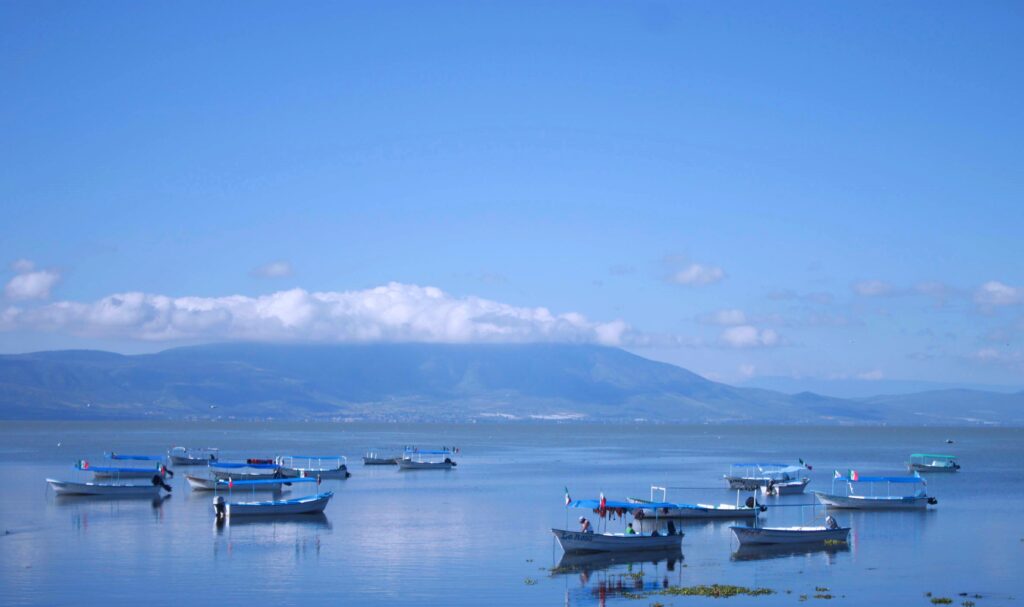Dating back almost 7 million years, Lake Chapala is one of the oldest lake ecosystems on the planet, and also the largest natural body of water in Mexico. The lake boasts a vast array of biodiversity and provides environmental services like freshwater (for human use and irrigation), fishing, and climate regulation. But its capacity to provide these services, vital for 4 million people, is being threatened by enormous pressures.
One of the main environmental issues is pesticide pollution from industrial agriculture, which is practised in 40% of the basin’s territory. More than 50% of these pesticides have high and extreme toxicity effects on the lake’s biodiversity, rich in endemic species – their effects are a serious concern for plankton, which is the basis of life in the lake, and on fish, which strongly harms local communities that depend on fishing. These toxic substances also affect the 307 bird species that inhabit the lake and its surrounding area.
Industrial agriculture also uses large quantities of industrial fertilisers, a significant proportion of which is not used by crops and ends up in Lake Chapala, washed away by rain. This leads to an abundance of floating plants, such as water lilies, which have become an obstacle to navigation and tourism, and causes the increasingly constant presence of “algae blooms” – during these dramatic events, which are particularly dangerous when cyanobacteria are involved, water turns green and the ecosystem is strongly altered.
Substantially reducing the chemical fertiliser and pesticide runoff that gets into the lake through streams and rivers is a priority. Instituto Corazon de la Tierra (ICT), a conservation entity with over 20 years of experience in the region, is working to fix this major problem as part of the Living Lakes Biodiversity and Climate Project.
Farming practices that benefit local livelihoods and Lake Chapala
Improving agricultural and livestock practices is key to solving the high inputs of agrochemicals into the lake. The application of good nutrition and crop care practices involves engaging local producers to reflect on and relearn how agro-ecosystems work, producing harmful chemicals-free products by using local, low-cost and easily accessible materials.
These actions also reduce carbon dioxide emissions into the atmosphere, improve conditions for the biodiversity of the lake and its watershed, and increase the benefits for farmers living around the Sierras de Chapala by reducing their production costs and limiting health risks. Furthermore, the Sierras de Chapala are key to ensuring water recharge for the lake and aquifers.

According to ICT, these issues are key to improve the health of aquatic ecosystems, conserve soils, protect biodiversity, combat climate change and ensure the preservation of environmental services associated with the lake and the surrounding mountains, the Sierras de Chapala.
The ICT works with more than 120 farmers through Field Schools (‘Escuelas de Campo’, ECAs), to accompany their learning and the application of Nature-Based Solutions (NBS) on their land, adjacent to the Sierras de Chapala Mountains. In the ECAs, members learn to produce their own agricultural products, exchange experiences, reflect on forest and water conservation, and improve their organisation.
Expected results by 2027
🌱 Reduction in the use of 635,000 kg of fertilisers and 12,200 kg of pesticide base substances.
🌍 Reduction of 1,000 tonnes of CO2 equivalent.
💸 50% cost reduction for farmers and livestock farmers.
💧Increased water infiltration in the region.
👩🏼🌾Increased climate resilience and adaptation.
Other ICT goals withing this project are: to apply agroecological learning and regenerative livestock farming in 1,000 hectares around two Natural Protected Areas (NPAs), to create Productive Buffer Belts; to open new Field Schools and maintain training for producers; to create an Inter-institutional Alternative Production Board; and to form two NPA Management Councils that integrate the inhabitants in decision-making to care for and sustainably use these forests.
Instituto Corazon de la Tierra, the Mexican partner of the Living Lakes Network, has been working in the region for more than 20 years, building long-standing relationships and mutual trust with local communities and farmers, and recognising their local and traditional ecological knowledge. Through these learning processes, farmers themselves have been able to recognise the environmental and economic advantages of halting the use of chemical fertilisers because: “A lake cannot thrive in a degraded watershed”.



